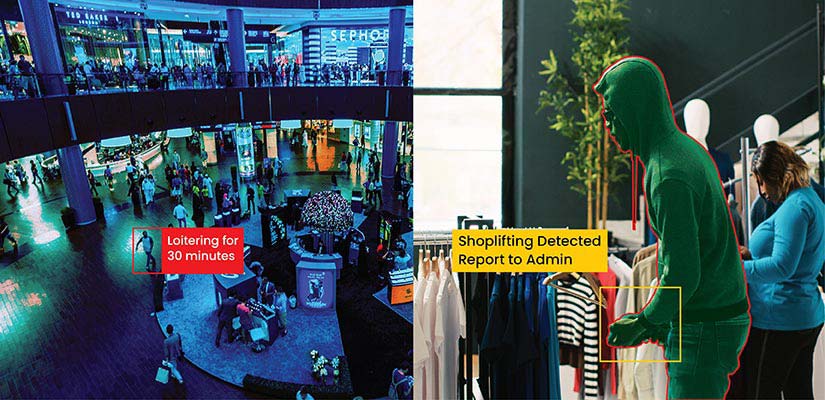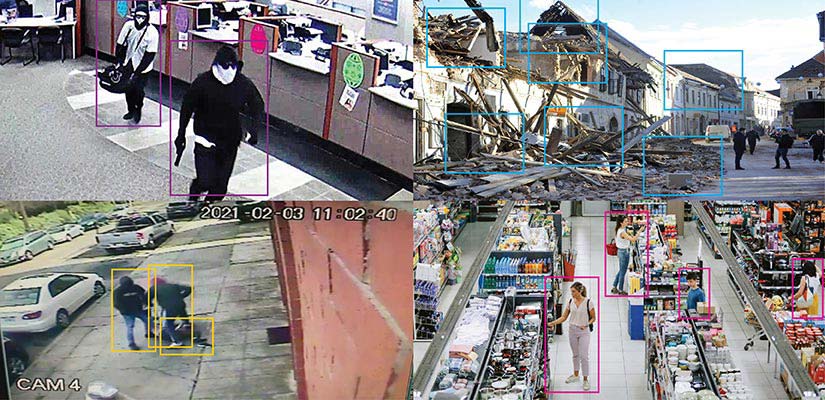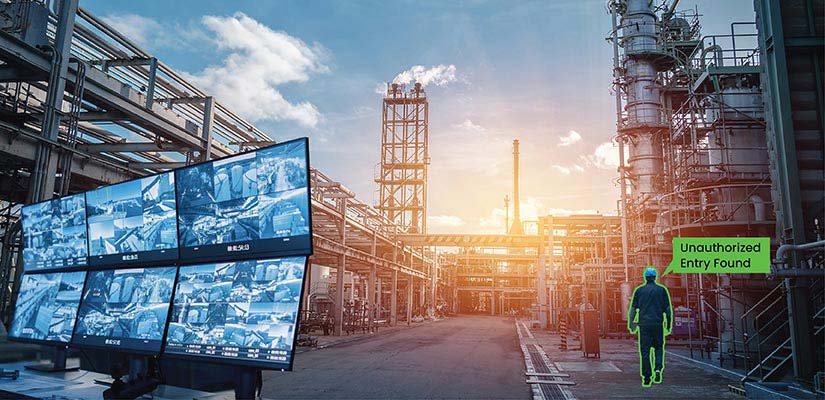- Video surveillance is essential for modern security. It deters crime, improves public safety, and provides evidence for investigations.
- AI-powered analysis enhances surveillance. Anomaly detection identifies unusual events, while video annotation helps AI systems understand and respond to threats.
- Continuous improvement is key as technology evolves, best practices and ethical considerations must be prioritized for reliable and fair surveillance systems.
Table of Contents
- What Is Anomaly Detection in Surveillance Videos and Why Is It Important?
- How Video Annotation Enables Anomaly Detection in Surveillance Systems
- Industry application of anomaly detection in video annotation
- Video annotation benefits for surveillance systems
- Top Techniques Used for Detecting Anomalies in Surveillance Videos
- How to detect and annotate anomalies in surveillance footage
- Challenges in video annotation and anomaly detection
- Conclusion
We are in an era where security and monitoring are critical, making video surveillance indispensable for ensuring safety in various environments, right from public spaces to private enterprises. The value of video surveillance is highlighted by its ability to deter crime, enhance public safety and provide critical evidence for investigations.
Anomaly detection and video annotation are crucial components of modern surveillance systems. The former involves identifying unusual patterns or activities that deviate from the norm, such as unauthorized access or suspicious behavior. This process is vital for preemptively addressing potential security threats. Video annotation, on the other hand, involves labeling and categorizing objects and events within video footage, enabling machine learning algorithms to recognize and respond to these anomalies effectively.
What Is Anomaly Detection in Surveillance Videos and Why Is It Important?
Anomaly detection in surveillance videos involves identifying abnormal events or patterns that deviate from the expected norm. In connection to video surveillance, anomalies are any unusual or unexpected occurrences that indicate potential security threats or irregularities.
These anomalies are typically categorized into three main types:
- Behavioral anomalies refer to suspicious activities or actions that deviate from typical human behavior within a monitored area. Examples include loitering in restricted zones, individuals running in typically calm environments, or unauthorized access to secure areas. Detecting these anomalies is essential for preemptively addressing potential security breaches or criminal activities.
- Object anomalies are unusual objects within the surveillance periphery. It includes unattended bags in public places, which could pose a security threat or the sudden appearance of objects that were not previously present. Identifying such anomalies is crucial for preventing incidents such as theft or the placement of hazardous materials.
- Environmental anomalies are unexpected changes in the physical environment captured by surveillance cameras. These include sudden changes like flickering lights or areas becoming unexpectedly dark, which indicate tampering or malfunctions. Changes in weather conditions or structural alterations within the monitored area are also termed environmental anomalies.
The detection of these anomalies relies on advanced machine learning algorithms and video annotation techniques. By accurately detecting and annotating these anomalies, surveillance systems provide real-time alerts and facilitate prompt responses to potential security threats, thereby enhancing overall safety and security.
Why is this important?
Effective anomaly detection enables proactive threat mitigation, improves incident response times, and enhances overall security and operational efficiency. When powered by AI and video annotation, surveillance systems can automatically detect and flag these anomalies, allowing for real-time monitoring and response.
How Video Annotation Enables Anomaly Detection in Surveillance Systems
Video annotation plays a pivotal role in detecting anomalies for surveillance projects. It enhances the capability of machine learning models to recognize and respond to unusual events. The activity primarily involves the meticulous labeling and categorization of objects, actions and events within video footage. This is how it provides the foundational data required for training AI systems to detect anomalies effectively. The entire process is crucial for ensuring that surveillance systems accurately identify potential security threats in real time.
Four key types of annotations are instrumental in anomaly detection:
- Object detection: This involves identifying and labeling objects within video frames. It is mainly used to recognize objects, such as vehicles, people or unattended bags, which may be relevant in identifying object anomalies.
- Object tracking: This extends object detection by following the movement of labeled objects across multiple frames. It helps in detecting behavioral anomalies, such as tracking a person moving erratically or entering restricted areas.
- Event classification: This is the process of categorizing specific actions or occurrences within the video, such as fights, falls or unauthorized entries. This type of annotation helps identify behavioral anomalies that deviate from expected patterns.
- Temporal segmentation: This divides video footage into segments based on changes in activity or context. This is useful for isolating periods of interest where anomalies are likely to occur, such as sudden changes in lighting or unexpected environmental shifts.
By leveraging these annotation types, surveillance projects can significantly improve their anomaly detection capabilities, leading to enhanced security and operational efficiency.
Industry application of anomaly detection in video annotation
Anomaly detection in video annotation has become an invaluable tool across various industries, enhancing security and operational efficiency through precise monitoring and analysis.
-
Retail Store Surveillance to Detect Theft:
In the retail sector, video annotation and anomaly detection are employed to identify suspicious activities, such as shoplifting or employee theft. By analyzing customer behavior and movement patterns, surveillance systems alert store personnel to potential thefts in real time, allowing them to take immediate action. This not only helps to reduce losses but also deters future incidents by maintaining a visible security presence.

-
Public Transportation Monitoring for Safety:
Public transportation systems utilize anomaly detection to ensure passenger safety and operational efficiency. Video annotation helps monitor crowd behavior, detect unattended bags, and identify unauthorized access to restricted areas. By promptly identifying these anomalies, transportation authorities address safety concerns, prevent accidents and enhance the overall passenger experience.

-
Industrial Site Surveillance for Accident Prevention:
In industrial settings, anomaly detection is crucial for maintaining safety and preventing accidents. Video annotation systems monitor equipment operation, detect unauthorized personnel in hazardous areas, and identify unsafe practices. By providing real-time alerts, these systems enable quick interventions, reducing the risk of accidents and ensuring compliance with safety regulations.

Across these industries, the application of anomaly detection in video annotation not only enhances security and safety but also optimizes operational processes, contributing to a more secure and efficient environment.
Video annotation benefits for surveillance systems
Video annotation significantly enhances surveillance systems by improving their ability to detect and respond to various security threats. By accurately labeling and categorizing objects, actions and events within video footage, video annotation equips AI models with the data required to identify and address anomalies effectively.

Here, we have listed four primary benefits of annotating videos for surveillance systems:
- Detecting Theft and Robbery: Annotated videos enable surveillance systems to recognize suspicious behaviors, such as loitering near valuable items or unauthorized access to restricted areas. By identifying these patterns, security personnel are alerted in real time to potential thefts or robberies, allowing for prompt intervention and prevention.
- Addressing Assault and Violence: Video annotation helps in classifying aggressive behaviors, such as physical altercations or threatening gestures. By training AI models to detect these actions, surveillance systems quickly alert authorities to incidents of assault or violence, facilitating faster response times and potentially preventing further harm.
- Mitigating Vandalism and Property Damage: Annotated surveillance footage aids in identifying acts of vandalism, such as graffiti or property destruction. By detecting these activities early, security teams are empowered to take immediate action to mitigate damage and apprehend perpetrators while preserving property integrity.
- Enhancing Arrest and Law Enforcement: By providing clear, annotated evidence of criminal activities, video annotation supports law enforcement efforts in identifying and apprehending suspects. This detailed documentation is crucial in legal proceedings, ensuring that justice is served.
Overall, video annotation enhances surveillance systems by providing them with the intelligence needed to detect and respond to security threats efficiently, ultimately contributing to safer environments and more effective law enforcement.
Top Techniques Used for Detecting Anomalies in Surveillance Videos
Anomaly detection in videos is a critical component of modern surveillance systems. It enables the identification of unusual activities or patterns that indicate security threats. The two primary techniques used in this process are image-level anomaly detection and pixel-level anomaly detection.
Image-Level Anomaly Detection:
This involves analyzing entire frames of video footage to identify deviations from expected patterns. This technique focuses on detecting anomalies based on the overall scene or context, such as:
- Recognizing unusual gatherings of people
- Unexpected vehicles in restricted areas
- Changes in environmental conditions
Image-level detection is beneficial for quickly identifying broad anomalies that may not require detailed analysis, but still indicate potential security concerns.
Pixel-Level Anomaly Detection:
This provides a more granular approach by examining individual pixels within video frames. This technique is particularly useful for detecting subtle anomalies, such as slight movements or changes in specific areas of a frame that could indicate tampering or unauthorized access.
Pixel-level detection is essential for high-precision surveillance applications, where even minor deviations from the norm can have significant implications.
Both techniques are integral to effective anomaly detection in surveillance videos. By leveraging image-level and pixel-level analyzes, surveillance systems can achieve a comprehensive understanding of their monitored environments, enabling timely and accurate responses to potential threats.
How to detect and annotate anomalies in surveillance footage
Detecting anomalies and annotating videos for surveillance projects is a complex process that involves both manual and automated techniques. Each approach comes with its own set of advantages and limitations, and the choices that AI and ML companies make depend on the specific requirements of the surveillance project.
Manual vs. Automated Detection:
Manual detection involves human operators reviewing video footage to identify anomalies. This method is highly accurate due to human intuition and experience, but it is time consuming and not scalable for large volumes of data. Automated detection, on the other hand, leverages algorithms and machine learning models to identify anomalies in real time. The automated approach is more efficient and scalable, allowing for continuous monitoring with minimal human intervention.
Machine Learning Approaches:
- Supervised Learning: This approach involves training models on labeled datasets where anomalies are explicitly marked. Supervised learning is effective when a comprehensive dataset with known anomalies is available, allowing the model to learn specific patterns associated with these anomalies.
- Unsupervised Learning: In scenarios where labeled data is scarce, unsupervised learning can be employed. This approach identifies anomalies by detecting deviations from normal patterns in the data. It is useful for discovering unknown or unexpected anomalies.
- Semi-supervised Learning: This method combines elements of both supervised and unsupervised learning, using a small amount of labeled data, along with a larger pool of unlabeled data. It is particularly useful when acquiring labeled data is challenging or expensive.
Common Algorithms and Models:
- Convolutional Neural Networks (CNNs): CNNs are effective for image-level anomaly detection and for identifying spatial hierarchies in video frames.
- Recurrent Neural Networks (RNNs): RNNs are suited for temporal analysis, capturing sequential dependencies in video data and making them ideal for detecting behavioral anomalies over time.
- Autoencoders: These models learn to reconstruct input data, identifying anomalies as instances with high reconstruction errors, indicating deviations from the norm.
- One-class SVMs: This algorithm is used for identifying outliers in data, making it suitable for scenarios where anomalies are rare and not well represented in the training data.
By integrating these techniques and models, surveillance projects can effectively detect and annotate anomalies, enhancing security and operational efficiency.
Challenges in video annotation and anomaly detection
Video annotation and anomaly detection in surveillance projects present several challenges that impact the effectiveness and reliability of these systems.
- Handling Large Volumes of Data: Surveillance systems generate vast amounts of video data, making it challenging to process and analyze efficiently. Annotating such large datasets manually is time consuming and labor intensive. Even automated systems require significant computational resources to handle continuous streams of data. Efficient data management and processing techniques are crucial to ensure timely and accurate anomaly detection.
- Dealing with Variations in Video Quality and Conditions: Variations in video quality, such as low resolution, poor lighting, or camera angles, hinder effective anomaly detection and annotation. These variations lead to missed detections or false positives. Developing algorithms that adapt to different video conditions and maintain high accuracy is a significant challenge.
- Addressing Biases in Annotation and Detection Algorithms: Biases in data annotation and detection algorithms lead to unfair or inaccurate outcomes. For instance, if training data is not diverse or representative, the models may perform poorly in certain demographics or scenarios. Ensuring that annotation processes are unbiased and that algorithms are trained on diverse datasets is critical for achieving fair and reliable results.
- Ensuring Data Privacy and Security: Video surveillance often involves sensitive information, raising concerns about data privacy and security. Ensuring that video data is protected from unauthorized access and breaches is critical. Implementing robust encryption and access control measures is essential to maintaining the confidentiality and integrity of the data.
Addressing these challenges requires a combination of advanced technologies, thoughtful data management strategies, and ethical considerations to enhance the effectiveness and fairness of video annotation and anomaly detection systems in surveillance projects.
Conclusion
Accurate anomaly detection and video annotation are essential components of modern surveillance systems and play a critical role in enhancing security and operational efficiency across various industries. As surveillance technologies continue to evolve, it is crucial to adopt best practices and continually improve methods to ensure reliability and fairness.
With ongoing advancements in AI and machine learning, the future holds immense potential for even more sophisticated surveillance solutions. These innovations promise to further enhance the effectiveness of monitoring systems, providing safer environments and more efficient responses to potential threats.
Identify abnormal events and security threats.
Real-time alerts and prompt responses to enhance overall safety and security.









